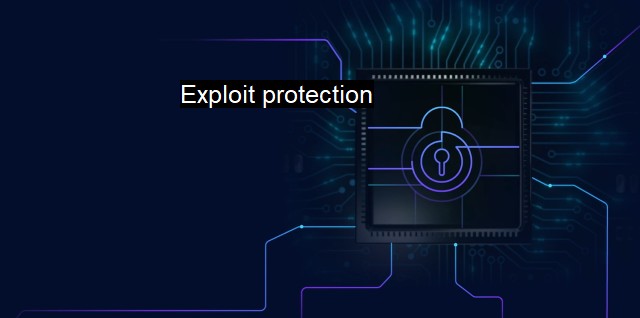What is Exploit protection?
The Importance of Exploit Protection for Cybersecurity: Techniques for Mitigating Software Vulnerabilities and Preventing Attacks
Exploit protection is a crucial aspect in cybersecurity designed to safeguard systems and networks from exploitation threats via malicious software. Various vulnerabilities within our systems can serve as potential wormholes for hackers to gain unauthorized access, steal sensitive information, or cause significant damage. Exploit protection has emerged as a front-line defense against these formidable cybersecurity threats.To understand exploit protection in depth, it is essential to define 'exploit.' An exploit references a component of software, data, or sequence of commands that leverages vulnerability or a bug within a system to initiate unintended behavior. This could potentially lend control of the system to an unauthorized individual or organization. Attackers exploiting vulnerabilities can execute malicious codes, manipulate data, create accounts with full user access rights or even deny access to legitimate users.
Exploit protection techniques have a stern focus on identifying and remedying vulnerabilities before a hacker discovers them. Several stages of exploit protection ensure this. It starts with writing secure code, rigorously testing for vulnerabilities through certain measures like penetration testing or peer reviews, and regularly updating and patching software to fix any vulnerabilities that might emerge over time.
In software development, secure coding serves as the first line of defense. It requires software to be developed with security as a critical consideration. Language selection can have profound implication on the program's security. Developers ought to avoid languages integral with automatic functions that can be exploited if not properly controlled. Buffer overflows exemplify vulnerabilities that can arise from languages like C++ that permit direct memory manipulation. Secure code avoids such channels and reduces vulnerability.
Another essential measure is regular vulnerability testing. A combination of both automated scripts that look for known vulnerabilities and manual testing to find new ones go a long way in identifying potential weak points that could be exploited.
Even after taking all these precautions, it is nearly impossible to rule out all vulnerabilities completely. Hence, it is vital for system administrators to consistently deploy patches and updates. These updates frequently include security patches that fix known vulnerabilities that could be exploited.
Another protective measure is an Exploit Protection Module (EPM), a newer and advanced level of exploit protection, used by antivirus software. The EPM monitors the behaviors of executables and prevents actions typical of exploit attempts. This can thwart zero-day exploits, protect memory, and system core files and it comes included with many premium antivirus services.
A closely related concept is the principle of least privilege (PoLP) that implies a user, program, or process should have only those privileges which are necessary to perform its intended function. Assigning additional (and unnecessary) user privileges increases the avenues of potential exploits.
One pivotal aspect of exploit protection is the defense against malware. Antivirus software is one crucial tool in this respect. Early antivirus software relied heavily on signatures to identify malware. But attackers gradually innovated ways to bypass these defenses. Modern antivirus software has since stepped ahead to not only protect against known threats but also to recognize behaviors indicative of new, unidentified malware.
Exploit protection encompasses a great deal of measures: secure coding, vulnerability testing, regular system updates and patches, use of EPM, antivirus software, and application of principle of least privilege among others. It serves as an ardent safeguard against vulnerabilities prone to exploitation by attackers. In an era marred by increasing cyber threats, a robust exploit protection strategy is no longer optional but a non-negotiable necessity. With the right tactics, technologies, and vigilant cyber-hygiene, individuals and organizations can put forward a competitive stance against cybersecurity threats.

Exploit protection FAQs
What is exploit protection?
Exploit protection is a security feature that helps protect against attacks that attempt to exploit vulnerabilities in software or operating systems. It is designed to prevent attackers from taking advantage of weaknesses in a system to gain unauthorized access, steal data, or execute malicious code.How does exploit protection work?
Exploit protection works by monitoring and blocking attempts to exploit known vulnerabilities. It uses various techniques such as sandboxing, code analysis, and behavior monitoring to identify and stop attacks. It also includes measures to stop the execution of malicious code, prevent privilege escalation, and limit the damage caused by successful attacks.Why is exploit protection important for cybersecurity?
Exploit protection is an essential component of a secure cybersecurity strategy. It helps prevent the most common type of attacks that use known vulnerabilities to gain access to systems and steal data. It also helps protect against zero-day attacks, which are attacks that exploit unknown vulnerabilities. By implementing exploit protection, organizations can significantly reduce the risk of data breaches, malware infections, and other cybersecurity threats.How can I implement exploit protection in my system?
To implement exploit protection in your system, you can use a variety of tools and technologies, including antivirus software, intrusion prevention systems, firewalls, and endpoint security solutions. You can also configure your operating system settings to enable exploit protection features such as Data Execution Prevention (DEP) and Address Space Layout Randomization (ASLR). Additionally, you should keep your software and operating system up-to-date with the latest security patches to ensure that known vulnerabilities are properly protected.| | A | | | B | | | C | | | D | | | E | | | F | | | G | | | H | | | I | | | J | | | K | | | L | | | M | |
| | N | | | O | | | P | | | Q | | | R | | | S | | | T | | | U | | | V | | | W | | | X | | | Y | | | Z | |
| | 1 | | | 2 | | | 3 | | | 4 | | | 7 | | | 8 | | |||||||